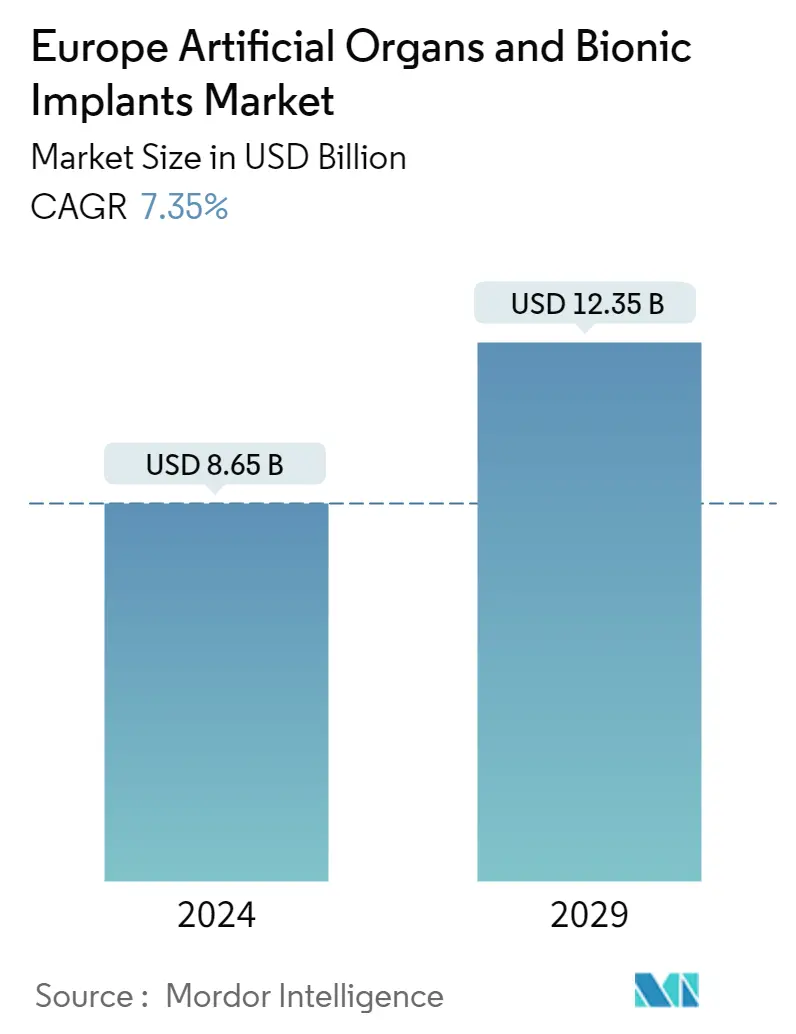Market Size of Europe Artificial Organs and Bionic Implants Industry

| Study Period | 2019 - 2029 |
| Base Year For Estimation | 2023 |
| Forecast Data Period | 2024 - 2029 |
| Market Size (2024) | USD 8.65 Billion |
| Market Size (2029) | USD 12.35 Billion |
| CAGR (2024 - 2029) | 7.35 % |
Major Players
*Disclaimer: Major Players sorted in no particular order |
Europe Artificial Organs & Bionic Implants Market Analysis
The Europe Artificial Organs and Bionic Implants Market size is estimated at USD 8.65 billion in 2024, and is expected to reach USD 12.35 billion by 2029, growing at a CAGR of 7.35% during the forecast period (2024-2029).
The onset of COVID-19 had a significant impact on the market studied. The number of transplants dropped in Europe during the initial phase of the pandemic. The decrease was certainly due to the risk of infection through the allograft, a significant increase in SARS-CoV-2-related morbidity and mortality in immunocompromised hosts. Kidney transplant and live donor programs were particularly affected, with significant negative spillover consequences for patients on the waiting list. According to a research study published in the Pathogens Journal in September 2022, higher mortality was seen during the pandemic among the transplant waiting list (TWL) patients compared to pre-COVID-19 TWL patients in Europe. It shows that there was a delay in transplantation procedures which further impacted the demand for artificial organs and bionics in the region. Hence, the market was affected adversely. However, the high burden of kidney diseases and cardiovascular diseases across Europe during the later phases of the pandemic created a demand for organ transplantations. This created opportunities for artificial organs and bionics and accelerated the market's growth in Europe. Hence, it is expected that the market will witness considerable growth over the analysis period.
Factors such as the rising incidence of organ failures, high Increased incidence of disabilities, scarcity of donor organs, and technological advancements leading to enhanced applications are anticipated to drive market growth over the forecast period.
Kidneys, the liver, lungs, the heart, the central nervous system, and the hematologic system are the major organs that tend to fail among the target population. In Europe, the number of organ failures has been increasing consistently over the few decades, but the number of organ donors is a few. This is creating demand for artificial organs in the region. As per a study published in the Nature Reviews Nephrology Journal in May 2021, changes in demographics and the burden of non-communicable diseases (NCDs) that are responsible for 77% of the disease burden in Europe were major components that increased the chance for organ transplantation in the region.
In addition, as per the European Committee on Organ Transplantation survey results published in September 2022, last year, kidney transplant was the most performed transplant in the European Union and accounted for 15,700 procedures, followed by 6,500 liver transplants and 2,000 heart transplants. This high number of transplants is anticipated to create opportunities for artificial organs and the bionics market in the region. Thus, this is anticipated to contribute to the global artificial organs and bionics implants market growth over the forecast period.
However, expensive procedures and fear of device malfunction and its consequences are expected to hinder the market's growth.
Europe Artificial Organs & Bionic Implants Industry Segmentation
As per the scope of the report, artificial organs are mechanical devices that can temporarily or permanently substitute for a body organ. These devices can replicate or augment the natural function of the organ. Bionics refers to the replacement or improvement of body parts by mechanical kinds.
The European Artificial Organs and Bionic Implants Market is Segmented by Type (Artificial Organs and Bionics) and Geography (Germany, United Kingdom, France, Italy, Spain, and the Rest of Europe). The report offers the value (in USD million) for the above segments.
| By Product | |||||||
| |||||||
|
| Geography | |
| Germany | |
| United Kingdom | |
| France | |
| Italy | |
| Spain | |
| Rest of Europe |
Europe Artificial Organs and Bionic Implants Market Size Summary
The European artificial organs and bionic implants market is poised for significant growth, driven by an increasing incidence of organ failures and a scarcity of donor organs. The market is experiencing a surge in demand due to the rising prevalence of chronic conditions such as kidney and cardiovascular diseases, which have been exacerbated by demographic changes and the burden of non-communicable diseases. Technological advancements in artificial organs and bionic implants are enhancing their applications, further propelling market expansion. Despite the challenges posed by the COVID-19 pandemic, which initially disrupted transplantation procedures, the subsequent demand for organ replacements has created opportunities for market growth. The market is characterized by a moderate level of competition, with key players focusing on technological innovations and strategic collaborations to capture market share.
In the United Kingdom, the market is witnessing growth due to an increase in disabilities and accidental injuries requiring amputations, alongside a rising waiting list for organ transplants. The shortage of live organ donors and the high cost of healthcare for conditions like diabetes-related amputations are driving the demand for artificial organs. The market's expansion is supported by ongoing clinical trials and funding for developing advanced implantable solutions. Major companies such as Sonova, Medtronic, and Ottobock are actively involved in product development and business expansion to meet the growing demand. Recent developments, such as the launch of the POWER KNEE by Össur, highlight the focus on innovative solutions to enhance the quality of life for patients with limb differences.
Europe Artificial Organs and Bionic Implants Market Size - Table of Contents
-
1. MARKET DYNAMICS
-
1.1 Market Overview
-
1.2 Market Drivers
-
1.2.1 Increased Incidence of Disabilities, Organ Failures and Scarcity of Donor Organs
-
1.2.2 Technological Advancements Leading to Enhanced Applications
-
-
1.3 Market Restraints
-
1.3.1 Expensive Procedures and Risk of Device Malfunction and its Consequences
-
-
1.4 Porter's Five Force Analysis
-
1.4.1 Threat of New Entrants
-
1.4.2 Bargaining Power of Buyers/Consumers
-
1.4.3 Bargaining Power of Suppliers
-
1.4.4 Threat of Substitute Products
-
1.4.5 Intensity of Competitive Rivalry
-
-
-
2. MARKET SEGMENTATION
-
2.1 By Product
-
2.1.1 Artificial Organs
-
2.1.1.1 Artificial Heart
-
2.1.1.2 Artificial Kidney
-
2.1.1.3 Cochlear Implants
-
2.1.1.4 Others
-
-
2.1.2 Bionics
-
2.1.2.1 Vision Bionics
-
2.1.2.2 Ear Bionics
-
2.1.2.3 Orthopedic Bionic
-
2.1.2.4 Cardiac Bionics
-
2.1.2.5 Others
-
-
-
2.2 Geography
-
2.2.1 Germany
-
2.2.2 United Kingdom
-
2.2.3 France
-
2.2.4 Italy
-
2.2.5 Spain
-
2.2.6 Rest of Europe
-
-
Europe Artificial Organs and Bionic Implants Market Size FAQs
How big is the Europe Artificial Organs and Bionic Implants Market?
The Europe Artificial Organs and Bionic Implants Market size is expected to reach USD 8.65 billion in 2024 and grow at a CAGR of 7.35% to reach USD 12.35 billion by 2029.
What is the current Europe Artificial Organs and Bionic Implants Market size?
In 2024, the Europe Artificial Organs and Bionic Implants Market size is expected to reach USD 8.65 billion.

